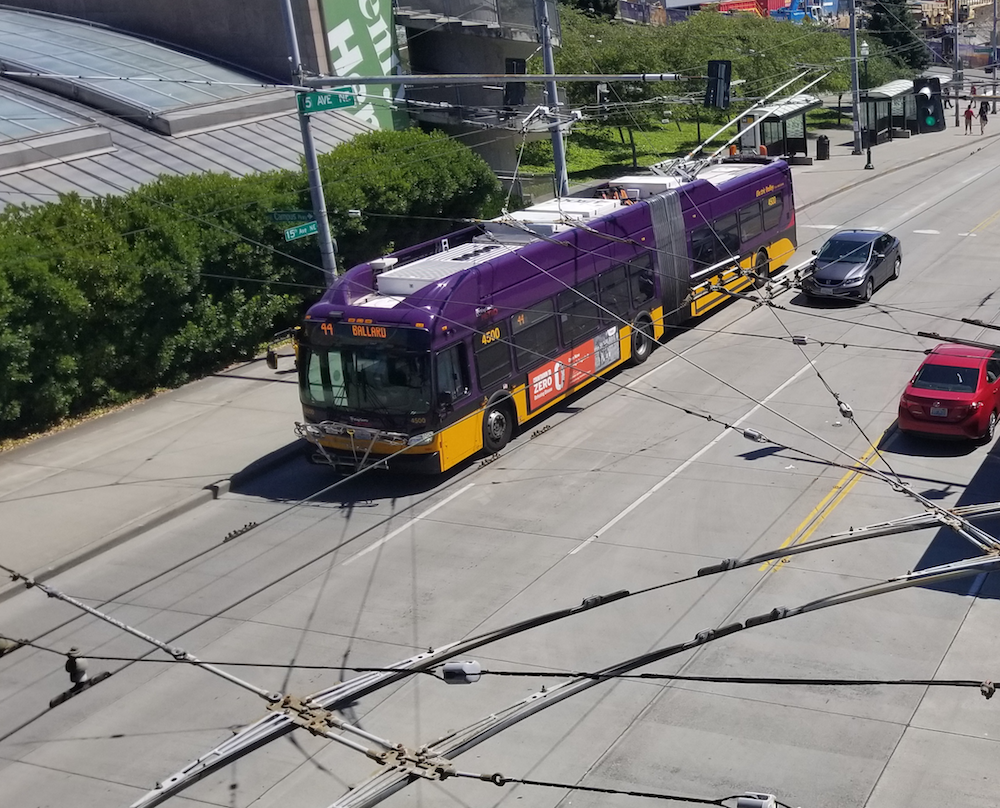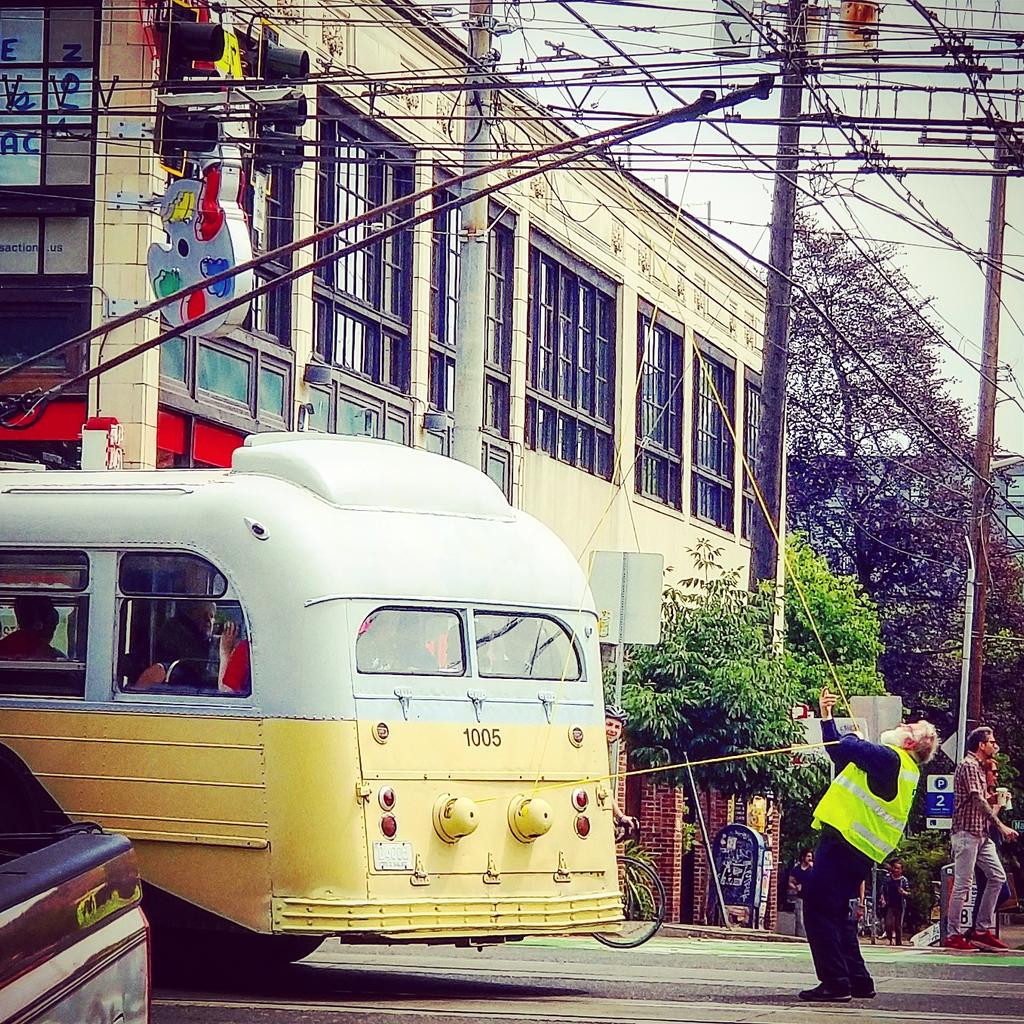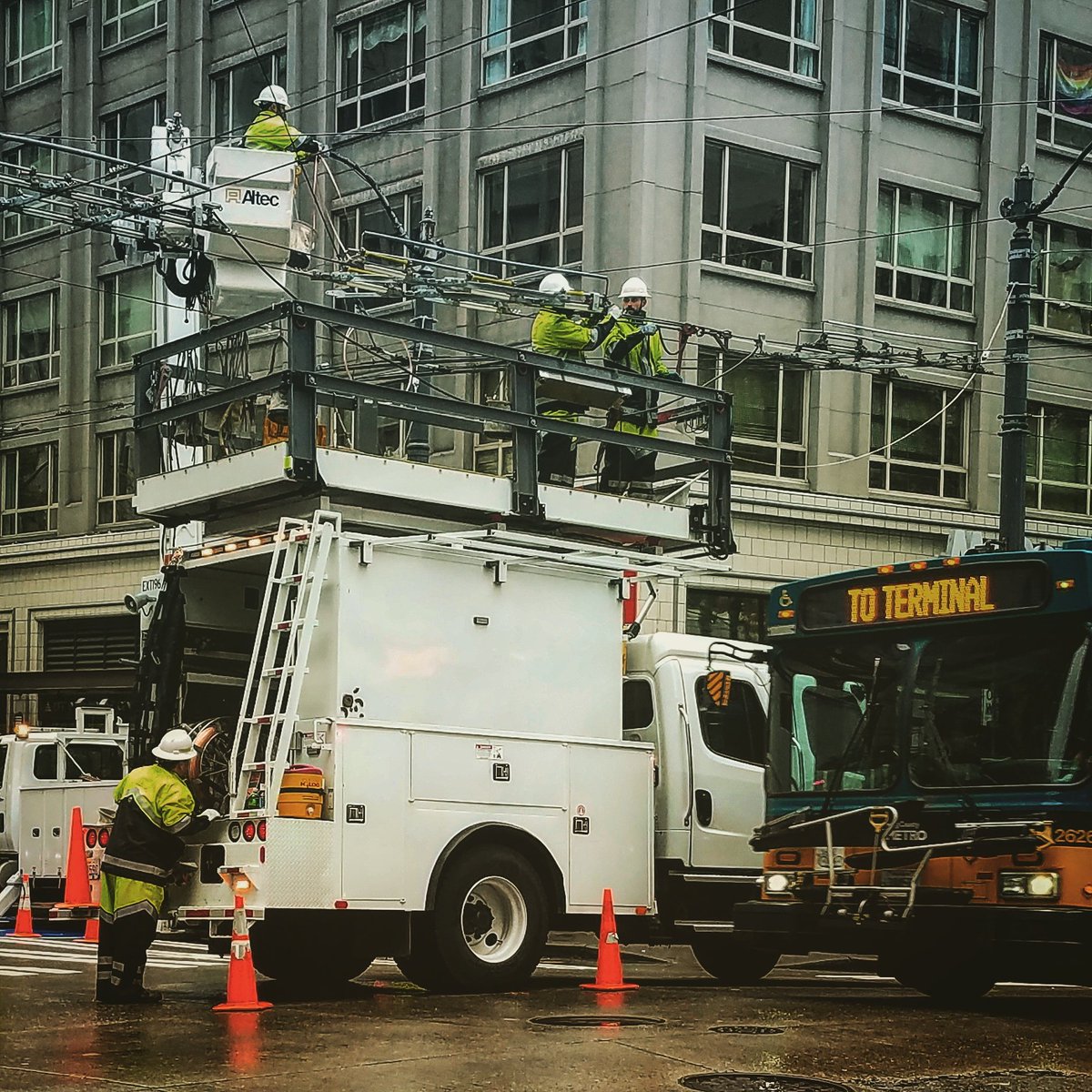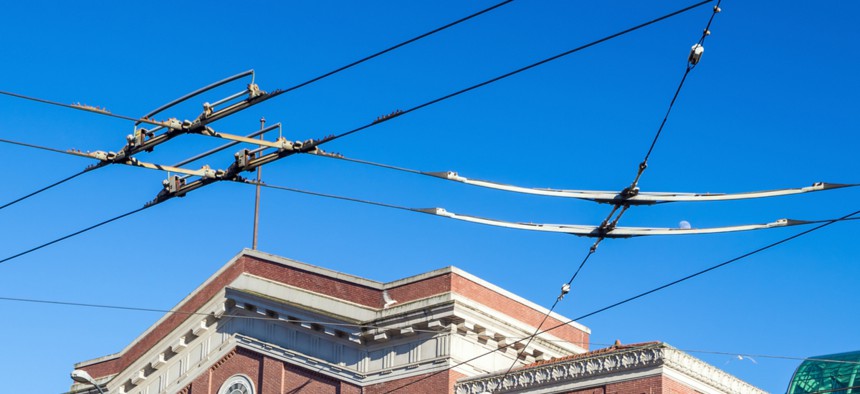Connecting state and local government leaders
When transportation planners drool over the Emerald City’s transit successes, they shouldn’t overlook the decades of investments in this legacy asset.
SEATTLE — In transportation circles, the word “trolley” can sometimes come with decades-old reputational baggage. Getting around on one might seem antique and quaint, best suited for tourists taking in local attractions at a leisurely pace, not daily commuters trying to get from Point A to Point B.
But that’s not the case in the Pacific Northwest’s largest city where there’s a nearly 80-year-old system of “trackless trolleys” in addition to more familiar transit modes like buses, streetcars and light rail. Instead of steel-wheeled vehicles guided by tracks set in the pavement and powered by a single overhead wire, the trolley network in Seattle uses rubber-tired buses and two poles that follow a set of overhead wires that deliver power to the vehicle.
Unlike streetcars that can’t leave their tracks, trolleybuses can travel around obstructions in the roadway—say, an Uber driver stopped to let out a passenger or an idling delivery truck—thanks to the flexible poles that are set on springs that allow such movement. In hilly cities like Seattle, electric trolleybuses are better at ascending long, steeper grades compared to diesel buses.

And because they’re electric, trolleybuses are cleaner and far quieter compared to diesel vehicles. The ride is far smoother, too, with braking technology that allows trolleybuses to return power to the overhead wires. Newer trolleybuses also have the ability to travel offwire for shorter distances on battery power.
There are only a five U.S. transit authorities that have trolleybuses in their fleets. The San Francisco Municipal Transportation Agency operates the nation’s largest such fleet. King County Metro, which operates bus service in Seattle and neighboring communities, has the nation’s second-largest system with 174 trolleys operating on 78 miles of overhead wire. Trolleybus routes carry approximately 20 percent of King County Metro’s weekday transit ridership.
There are smaller trolleybus networks in the Boston area, Philadelphia and Dayton, Ohio.
In Seattle, decisions made over the course of many decades to maintain, rebuild and expand the trolleywire network gives today’s local officials an environmentally-friendly infrastructure asset, something that nearly all other U.S. local governments can’t rely on when pursuing goals to reduce greenhouse gas emissions.
While improvements in battery-powered bus technology and performance in the past few years—and decreasing costs—have made it easier for transit agencies to embrace electric vehicles, there are no signs officials might want to scrap Seattle’s legacy overhead trolleywire network. In fact, local agencies are making longer-term investments to maintain and expand it.
A Trip Back in Time

Why does a trolleybus network exist in Seattle to begin with? It’s a relic of the former Seattle’s former streetcar network, which was decommissioned in the early 1940s in favor of rubber-tire buses. But a decision was made to retain the overhead wire network to run trolleybuses in addition to non-electric buses.
On July 4, Route Fifty took a ride in a convoy of vintage trolleybuses maintained by the Metro Employee Historic Vehicle Association, and traversed much the city from the Beacon Hill neighborhood through downtown to Capitol Hill, the University District and Ballard.
The power poles on the lead historic trolleybus encountered some periodic difficulties navigating wire junctions, but overall, while the hum of the electric motor and the dated interiors were different, the transit experience of moving along Seattle’s trolleybus routes was fairly similar to what you’d experience today in a vehicle from the newer fleet.

The wire network, first used for streetcars, enabled Seattle’s growth as a city in the early 20th century. And all these years later, the overhead wires serve as an informal wayfinding tool when exploring the city since they often connect key commercial corridors, neighborhood centers and other points of interest, like the University of Washington. They’ve long been part of Seattle’s infrastructure landscape and will continue to serve as a type of urban stitching in a similar way to how New Yorkers may identify with subway lines in the city.
Reinvesting and Expanding the Wire Network
While wires were removed from some routes following World War II, significant sections of the network remained, especially downtown and in the Capitol Hill and Queen Anne neighborhoods. In the 1970s, local leaders decided to totally overhaul the existing wire network, restarted service on previously eliminated routes and expanded it from the University of Washington to the Ballard neighborhood along what is today’s crosstown Route 44, among the most heavily used bus routes in Seattle.
When the previous fleet was approaching the end of its useful lifespan earlier this decade, leaders in Seattle had a decision of whether to keep the trolleybus network or scrap it. They decided to team up with their counterparts in San Francisco on a large trolleybus vehicle procurement. The New Flyer trolleybuses, deployed to Seattle streets in 2014, consist of 40-foot and articulated 60-foot vehicles, the latter of which seem far roomier and move faster than many modern light-rail vehicles in operation in some U.S. cities.
As some cities have pursued investments in modern streetcars, some critics have pointed to how buses can move more swiftly through mixed traffic compared to streetcars that are limited by where their steel rails allow them to travel.
A trolleybus, in some ways, is a nice half-step between a streetcar and a traditional bus, especially when relatively modest transit investments, like bus-only lanes and signal priority, can help speed vehicles through congested areas.

The 78-mile trolleybus network in Seattle is set to see some modest expansion in the years to come. There are three projects, as envisioned by Seattle and King County planners, that will extend the webbing of trolleybus wires in key corridors.
One has been gradually taking shape along 23rd Avenue, an important north-south arterial corridor that currently hosts Route 48. While much of the route already has trolleywire, there are a few gaps. As the Seattle Department of Transportation has been rebuilding the 23rd Avenue corridor—construction will continue into 2019—it has erected large steel poles that will accommodate future trolleywire expansion. And that will set the stage for the full electrification of the bus route, which is slated to be upgraded and rebranded as one of King County Metro’s RapidRide lines, which offer frequent, faster service.
Two other RapidRide projects in Seattle—which will bring improved bus service to the Madison Street corridor and a route connecting downtown with the Eastlake, University District and Roosevelt areas—are also slated to see some expansion of overhead trolleybus wires along with transit-priority lanes and signal priority in some areas.
Seattle's Department of Transportation has struggled to keep up with what was promised through the 2015 Move Seattle transportation-funding levy—prompting Mayor Jenny Durkan’s administration to assess various projects that have been in the planning pipeline. But Seattle continues to be a national transit success story, being among the few U.S. cities to see its transit ridership increase, particularly on its bus system.
That’s a big lesson about trolleybuses: Not all transportation innovation has to involve new technology. In Seattle and elsewhere, taking decades-old infrastructure and improving it can prove to be a wise zero-emissions investment that ends up moving a lot of people.
Michael Grass is Executive Editor of Government Executive’s Route Fifty and is based in Seattle.

NEXT STORY: An Uncomfortable Reminder of Why You Shouldn’t Take Air Conditioning for Granted




